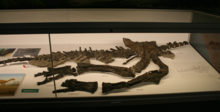Valdosaurus
| Valdosaurus Temporal range: Early Cretaceous, | |
|---|---|

| |
| Assigned skeleton at Dinosaur Isle Museum | |
| Scientific classification | |
| Domain: | Eukaryota |
| Kingdom: | Animalia |
| Phylum: | Chordata |
| Clade: | Dinosauria |
| Clade: | †Ornithischia |
| Clade: | †Neornithischia |
| Clade: | †Ornithopoda |
| Family: | †Dryosauridae |
| Genus: | †Valdosaurus Galton, 1977 |
| Species: | †V. canaliculatus |
| Binomial name | |
| †Valdosaurus canaliculatus Galton, 1977 (Galton, 1975) | |
| Synonyms | |
| |
Valdosaurus ("Weald Lizard") is a genus of bipedal herbivorous iguanodont ornithopod dinosaur found on the Isle of Wight and elsewhere in England, Spain and possibly also Romania. It lived during the Early Cretaceous.
Discovery and naming

In the nineteenth century Reverend William Darwin Fox collected two small thighbones near Cowleaze Chine on the southwest coast of the Isle of Wight. In 1868 he incorrectly suggested these may have come from the same individual that had in 1848 been uncovered for Gideon Mantell as a fossil of Iguanodon, and which in 1869 would be named as the new genus Hypsilophodon. Regardless, both femora, made part of the collection of the British Museum of Natural History as specimens BMNH R184 and BMNH R185, would be commonly referred to the latter genus.
However, in 1975 Peter Galton named them as a new species of Dryosaurus: Dryosaurus canaliculatus. The specific name means "with a small channel" in Latin, referring to a distinct groove between the condyles of the lower thighbone.[1] In 1977 Galton named a new genus for them: Valdosaurus, the name being derived from Latin Valdus, "Wealden", a reference to the Wealden Group. Its type species, D. canaliculatus, was thus renamed V. canaliculatus.[2] A second species, V. nigeriensis, was described by Galton and Philippe Taquet from younger rocks from Niger in 1982;[3] this has since been transferred to its own genus, Elrhazosaurus.
In 1998 William Blows inadvertently named another species, Valdosaurus dextrapoda, by including this name in a fauna list,[4] but this was an error, and the species has never been supported.[5][6] Lacking description, it is a nomen nudum.
In 2012, a new specimen of Valdosaurus was discovered,[7] and it was described in 2016.[8] The specimen is the most complete yet found, which was found in articulation and includes a partial dorsal series, an almost complete tail, pelvic material, and both hind limbs. In life, the specimen would have been around 4–5 metres (13–16 ft) long.[8]
Classification
Galton assigned Valdosaurus to the Hypsilophodontidae,[1][2] but this paraphyletic unnatural group has largely been abandoned. Today Valdosaurus is generally considered a member of the Dryosauridae.[9]
Palaeoenvironment

Having a close European relative of the American form Dryosaurus named led to most of the dryosaurid fossil material of Europe being referred to Valdosaurus. Valdosaurus was seen as not only present in England (the Wessex Formation of the Isle of Wight and the Hastings Beds of West Sussex) but probably also in Spain[citation needed]. These rock units were deposited between the Berriasian and Barremian stages, between approximately 145 and 125 million years ago. V. canaliculatus would then be known from thigh bones, extensive additional postcranial elements, partial lower jaws, and teeth.[9]
In 2009 however, Galton critically reviewed the Valdosaurus material. He concluded that no fossils from outside England could be reliably referred to the genus. He thus gave V. nigeriensis its own genus: Elrhazosaurus. Even of many of the English specimens it was uncertain whether they belonged to Valdosaurus, including all cranial elements and teeth. Some hindlimb and pelvis bones from the Upper Weald Clay Formation (late Barremian) were referable to V. canaliculatus. Some material from the earlier Hastings Beds (Valanginian) were referred to a Valdosaurus sp. Galton established that Richard Owen had in 1842 been the first to describe Valdosaurus thighbones, specimens BMB 004297-004300, assigning them to Iguanodon. Galton emphasized that though the type femora were very small, fourteen centimetres long (which has led to estimates of a length of 1.2 metres and a weight of ten kilograms[10]), these were from a juvenile individual and that an adult would have been a "medium-sized euornithopod", with some thighbones reaching a length of half a metre.[6]
See also
References
- ^ a b Galton, P.M., 1975, "English hypsilophodontid dinosaurs (Reptilia: Ornithischia)", Palaeontology 18(4): 741-752
- ^ a b Galton, P.M., 1977. "The Upper Jurassic dinosaur Dryosaurus and a Laurasia-Gondwana connection in the Upper Jurassic", Nature 268(5617): 230-232
- ^ Galton, P.M. & P. Taquet, 1982, "Valdosaurus, a hypsilophodontid dinosaur from the Lower Cretaceous of Europe and Africa", Géobios 13: 147-159
- ^ Blows, W.T., 1998, "A review of Lower and Middle Cretaceous dinosaurs of England", New Mexico Museum of Natural History and Science Bulletin, Albuquerque 14: 29-38
- ^ Martill, D.M. and Naish, D., 2001, "Ornithopod dinosaurs." Pages 60-132 in Martill, D.M. and Naish, D. (eds.). Dinosaurs of the Isle of Wight, The Palaeontological Association, London.
- ^ a b Galton, P.M., 2009, "Notes on Neocomian (Late Cretaceous) ornithopod dinosaurs from England - Hypsilophodon, Valdosaurus, "Camptosaurus", "Iguanodon" - and referred specimens from Romania and elsewhere", Revue de Paléobiologie 28(1): 211-273
- ^ Lockwood, Jeremy A. F.; Martill, David M.; Maidment, Susannah C. R. (2024-12-31). "Comptonatus chasei, a new iguanodontian dinosaur from the Lower Cretaceous Wessex Formation of the Isle of Wight, southern England". Journal of Systematic Palaeontology. 22 (1). Bibcode:2024JSPal..2246573L. doi:10.1080/14772019.2024.2346573. ISSN 1477-2019.
- ^ a b Barrett, Paul. (2016). A new specimen of Valdosaurus canaliculatus (Ornithopoda: Dryosauridae) from the Lower Cretaceous of the Isle of Wight, England. Memoirs of Museum Victoria. 74. 29-48. 10.24199/j.mmv.2016.74.04.
- ^ a b Norman, David B. (2004). "Basal Iguanodontia". In Weishampel, D.B.; Dodson, P.; Osmólska, H. (eds.). The Dinosauria (2nd ed.). Berkeley: University of California Press. pp. 413–437. ISBN 0-520-24209-2.
- ^ Paul, G.S., 2010, The Princeton Field Guide to Dinosaurs, Princeton University Press p. 283

